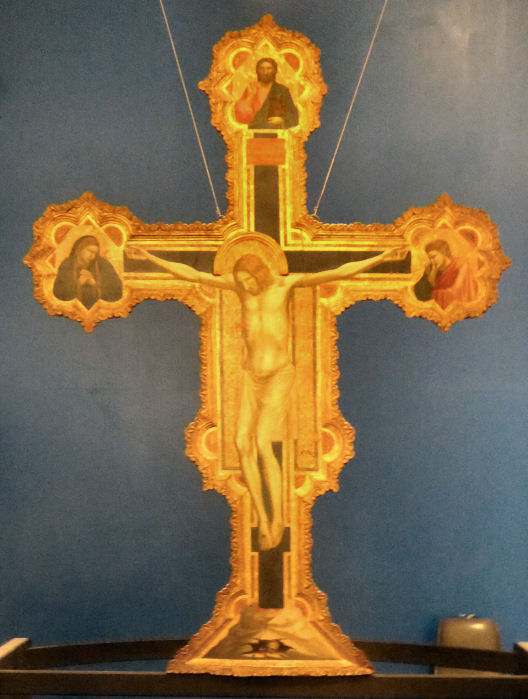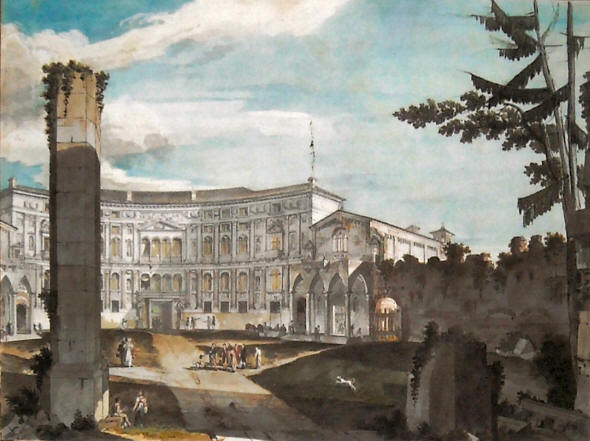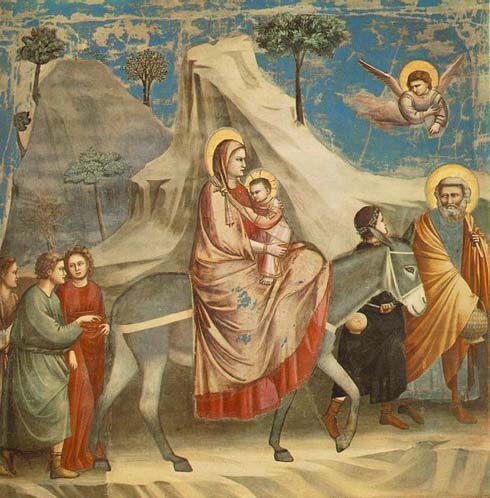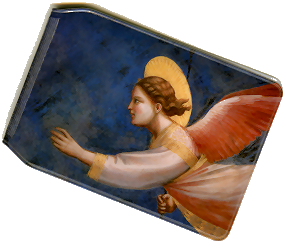|
History
A small chapel dedicated to Santa Maria Annunziata stood here originally,
at least since 1278, and a procession and mystery play celebrating the Annunciation was held
here on the feats day every 25th of March. In 1300 banker Enrico Scrovegni bought
from the noble-but-impoverished Dalesmanini family an enormous area of land which included the
chapel and the eastern part of the Roman Arena, which was of a size and
appearance to match the Arena in Verona. Scrovegni built a palace and rebuilt
the chapel. It was dedicated to Santa Maria della CaritÓ at the Feast of the Annunciation in
1303, when rebuilding began, and consecrated on 25th March 1305, by which
date the fresco decoration by Giotto and his workshop had also been
completed. It is
now better known as the Arena
Chapel or the Scrovegni Chapel. It was built next to the palace as a family oratory, but was also used
for the long-established service during the Feast of the Annunciation.
Enrico Scrovegni's fortune was derived from money lending, and usury was
at the time thought to be a sin so grave as to exclude those guilty of it
from the benefit of Christian sacraments. There is a widely held and
written-about belief
that Enrico built and changed the dedication of the chapel in penance for his father's sin of usury.
His father, Rainaldo, had been a social climber nonetheless famous for
singing lewd songs in his youth. Later he was one of the usurers mentioned in
Dante's Inferno - his arms (a blue sow on a white field) were
placed in the seventh circle of the Inferno. (Dante and Giotto are said to have
been friends, with Dante staying in Giotto's house.) But the theory that
Enrico built the Arena Chapel to make restitution for his father's usury has
been questioned in recent years. He was law-abiding lender and had set
aside funds in his will for any challenges after his death, and Enrico
himself had not exactly scrimped on bequests and philanthropy already.
Enrico died, and was buried, in exile in Venice on the 20th of August
1336, having been the victim of double-dealing allies, including Giacomo and Marsilio da Carrara.
He had fled Padua in 1320, ahead of his to his formal banishment in 1328.
He was buried initially in the Camaldolese monastery of
San Mattia on Murano, but his body was
moved to a tomb in the apse here three months after his death, on 23rd
November 1336. It features a Virgin and Child and two Angels, by
Giovanni Pisano from c.1303ľ18. including Giacomo and Marsilio da Carrara.
He had fled Padua in 1320, ahead of his to his formal banishment in 1328.
He was buried initially in the Camaldolese monastery of
San Mattia on Murano, but his body was
moved to a tomb in the apse here three months after his death, on 23rd
November 1336. It features a Virgin and Child and two Angels, by
Giovanni Pisano from c.1303ľ18.
Giotto was also an architect and
so it has recently been argued that he may have designed the chapel too. But it is also
argued that the architect was Fra Giovanni Eremitano, who lived in the
neighbouring Eremitani and is said to be the monk holding the model of the
chapel with Enrico Scrovegni in Giotto's fresco of The Last Judgement
on the entrance wall (see detail right).
The palace later
passed to the Foscari family and was demolished in 1827, the chapel having
also then been slated for demolition two years later.
Fragments of the palace remain in Padua - the Palazzo del Monte di PietÓ
has six bays in the arcade at the left of its fašade and a bit of doorway
in its wall.
Interior
It is thought that, having been brought here by the Franciscans to
work in the Santo after his work at Assisi, it was whilst working there
that Giotto met Enrico Scrovegni - he also frescoed a Scrovegni family chapel
there - which led to his commission to decorate the Arena Chapel. It seems
that Giotto and his workshop worked fast, as the decoration is thought to
have been finished at the same time as the consecration in 1305. The
chapel has a rectangular barrel-vaulted nave, six tall windows along the right-hand
side and a three-light window high in the fašade. The small chancel was
finished later with fresco decoration by a a lesser Paduan painter. It is
flanked by a pair of small side altars, also of a later date. Above the
arch, the image of God the Father is actually tempera on panel, and
this panel is a window shutter.
To the left of the chancel arch and the
Annunciation is another window (visible in the photo left)
whichthe female members of the Scrovegni family would have worshipped
behind, having walked down a corridor from their palazzo next door.
The interior space seems designed for decoration with frescoes,
possibly on Giotto's advice, with a lack of architectural
embellishment and windows facing south-east. Giotto's frescoes here,
painted c.1303-5, are
unarguably his finest work, and certainly the best preserved, with
thirty-seven scenes from the lives of Mary and Jesus. They are also one of the
very rare uncontested examples of his work. But
they were only really universally accepted as of unique importance
and quality in the 20th century, as
the quote below from Ruskin illustrates. Vasari never even saw them, Padua
being so small and far from Florence. Their
centuries of neglect were halted in 2002, when the chapel reopened after
restoration.
The vivid blue star-studded ceiling has painted medallions - Christ
surrounded by four prophets (including John the Baptist) on the half
nearest the altar; the Virgin and four more prophets nearest the entrance. The series depicting the
life of the Virgin begins at the top left of the right-hand wall. By the
time the series reaches the left hand wall it's into the life of Jesus.
Ruskin wrote
The drawing of Giotto is, of course, exceedingly faulty. His
knowledge of the human figure is deficient.
Lost art
A painted Crucifix (see right) and a panel of God the
Father, both by Giotto and painted for this chapel, are now in the Eremitani
Civic Museum next door. The Crucifix is signed by Giotto, is
painted on both sides (the reverse being pretty ruined and featuring a
painting of the Mystic Lamb and symbols of the Four Evangelists) and was
probably painted at the same time as the frescoes. It may well have been
placed on a screen between the nave and presbytery. It was restored in the
early 1990s.
Opening times
Monday to Sunday 9.00 - 7.00
Pre-booking is essential
www.cappelladegliscrovegni.it
You wait in an air-conditioned waiting-room watching a
video for 15 minutes (to 'stabilise the interior microclimate') then enter
the Chapel for a 15 minutes, so visits last about 30 minutes.
Bibliography
Laura Jacobus Giotto and the Arena Chapel 2008
All you'll ever need to know, and more.
(This is now eye-wateringly expensive second-hand
but a new edition has long been promised)

A mid-18th century watercolour by Marino Urbani showing the
chapel (centre)
when it
was attached to the Scrovegni family palazzo, then known as the
Palazzo Foscari.
|
|




 |